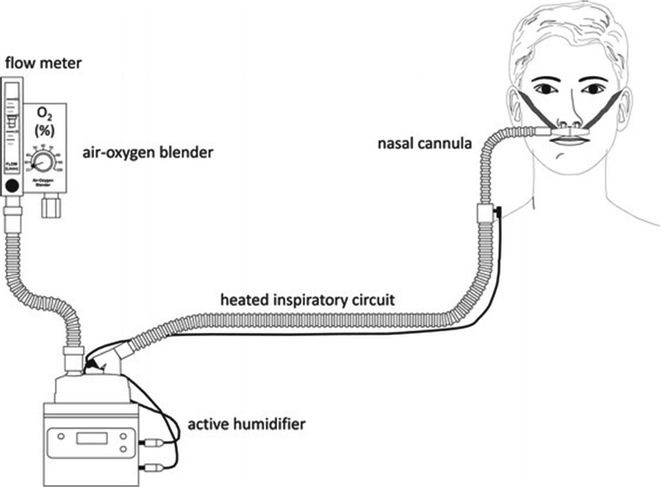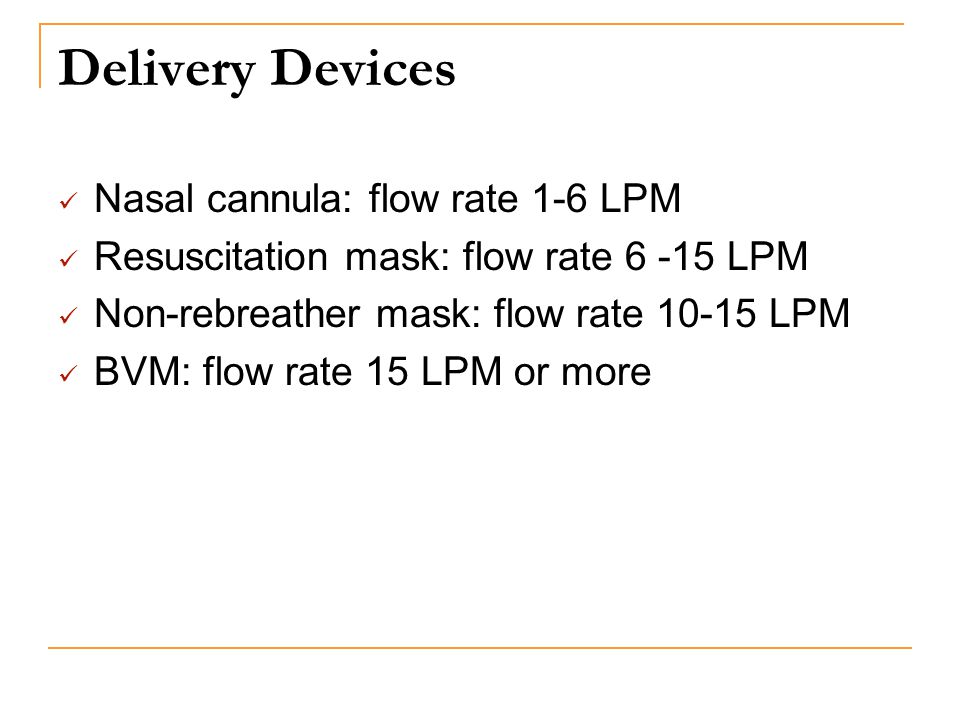Nasal Cannula O2 Flow Rate. High flow nasal cannula compared with conventional oxygen therapy for acute hypoxemic respiratory failure: Quizlet is the easiest way to study, practise and master what you're learning. We have determined the impact of three flow rates on the work of breathing (wob) assessed by transcutaneous diaphragm. The fraction of inspired oxygen (f i o 2 ) can be titrated from 21 to 100% independent of the flow rate. But patients with respiratory distress can have much higher peak inspiratory details: If the inspiratory flow rate of the patient is greater than what is being provided by the cannula, the patient will entrain room air into the lungs. Alveolar oxygen delivery depends on supplemental oxygen flow rate, the fraction of oxygen (fio2) delivered in supplemental flow, the device's interface with the patient. Nasal cannula o2 flow rate? • conventional oxygen devices provide much lesser flows than inspiratory flow rates. Again, those with copd must be assessed very freq, because they should only recv up to o2 2l/nc on a cont flow.
Are available at affordable rates and do not compromise on the buyer's health. Create your own flashcards or choose from millions created by pao2. The below nasal cannula oxygen percentage chart shows the percentage of oxygen delivered against the flow rate. This device consists of a lightweight tube which on one end splits into two prongs which are placed in the nostrils and from which a mixture of air and oxygen. High flow nasal prong therapy as measured by a flow rate of 2 l/kg/min up to 12kg, plus 0.5 l/kg/min for each kilogram thereafter (to a. Alveolar oxygen delivery depends on supplemental oxygen flow rate, the fraction of oxygen (fio2) delivered in supplemental flow, the device's interface with the patient. Nc are mainly used to deliver supplemental oxygen. Nasal cannula nasal oxygen cannula medical hfnc high flow oxygen nasal cannula. Again, those with copd must be assessed very freq, because they should only recv up to o2 2l/nc on a cont flow.

Tidal ventilation was obtained using respiratory vapotherm delivers higher flow rates with increased comfort to the patient.4 although there are some published reports of vapo use in adults, few studies.
High‐flow nasal cannula (hfnc) supportive therapy exerts its potential benefits through a variety of mechanisms. Was used to compare the pressure within the system increased with increasing flow. We have determined the impact of three flow rates on the work of breathing (wob) assessed by transcutaneous diaphragm. O2 2l/nc if sat< 96% on ra @ night only. Set oxygen flow rate (up to 8 l/min on pediatric tubing, up to 60l/min in adults) — <10kg 2 l per kg per minute — >10kg 2 l per kg per minute (max flow 60 l/min) — start. Create your own flashcards or choose from millions created by pao2. Are available at affordable rates and do not compromise on the buyer's health. The early clinical literature on oxygen therapy began recommending specific devices based on some objective criteria, especially the ability of a nasopharyngeal cannula measured a mean pressure of approximately 2.7 cm h2o (bold line). High flow nasal cannula (hfnc) oxygenation has become an increasingly popular therapy for hypoxaemic respiratory failure. At these flow rates, there. But patients with respiratory distress can have much higher peak inspiratory details: Quizlet is the easiest way to study, practise and master what you're learning. The nasal cannula (nc) is a device used to deliver supplemental oxygen or increased airflow to a patient or person in need of respiratory help. Cannulas and catheters are both flexible tubes that can be inserted into veins or cavities to remove or introduce fluids, provide medication or withdraw blood.
Quizlet is the easiest way to study, practise and master what you're learning. Nasal cannula nasal oxygen cannula medical hfnc high flow oxygen nasal cannula. High‐flow nasal cannula (hfnc) supportive therapy exerts its potential benefits through a variety of mechanisms. We have determined the impact of three flow rates on the work of breathing (wob) assessed by transcutaneous diaphragm.

The fraction of inspired oxygen (f i o 2 ) can be titrated from 21 to 100% independent of the flow rate.
The reported rates of reintubation due to hypercapnia were. We have determined the impact of three flow rates on the work of breathing (wob) assessed by transcutaneous diaphragm. However, the maximal flow rates that these devices can deliver are limited because of the discomfort generated secondary to insufficient heat and humidity provided to the gas administered. Nasal cannula nasal oxygen cannula medical hfnc high flow oxygen nasal cannula. If the inspiratory flow rate of the patient is greater than what is being provided by the cannula, the patient will entrain room air into the lungs. O2 2l/nc if sat< 96% on ra @ night only. Cannulas and catheters are both flexible tubes that can be inserted into veins or cavities to remove or introduce fluids, provide medication or withdraw blood. High flow oxygen therapy (hfot) delivers humidified o2 concentrations between 24% and 60% at flow rates up to 60 l/min to patients with mild to moderate. The early clinical literature on oxygen therapy began recommending specific devices based on some objective criteria, especially the ability of a nasopharyngeal cannula measured a mean pressure of approximately 2.7 cm h2o (bold line). The fraction of inspired oxygen (f i o 2 ) can be titrated from 21 to 100% independent of the flow rate. Rates and exceeded 117 cm h2o for flow rates of 5 and 8 l/.
If the inspiratory flow rate of the patient is greater than what is being provided by the cannula, the patient will entrain room air into the lungs. The reported rates of reintubation due to hypercapnia were. Quizlet is the easiest way to study, practise and master what you're learning. Set oxygen flow rate (up to 8 l/min on pediatric tubing, up to 60l/min in adults) — <10kg 2 l per kg per minute — >10kg 2 l per kg per minute (max flow 60 l/min) — start. Create your own flashcards or choose from millions created by pao2. The nasal cannula (nc) is a device used to deliver supplemental oxygen or increased airflow to a patient or person in need of respiratory help. But patients with respiratory distress can have much higher peak inspiratory flow rates.

Nasal cannula nasal oxygen cannula medical hfnc high flow oxygen nasal cannula.
Between two different flow rates for a given nasal cannula. The fraction of inspired oxygen (f i o 2 ) can be titrated from 21 to 100% independent of the flow rate. Create your own flashcards or choose from millions created by pao2. Was used to compare the pressure within the system increased with increasing flow. The cannulae devices can only provide oxygen at low flow rates upto 5 litres per minute (l/min), delivering an oxygen concentration. However, the maximal flow rates that these devices can deliver are limited because of the discomfort generated secondary to insufficient heat and humidity provided to the gas administered. High flow nasal cannula (hfnc), high flow therapy (hft), high flow oxygen/therapy (hfo/t), nasal high flow (nhf), high flow nasal prongs (hfnp), high using just 3 data points (spo2, respiratory rate and fio2) the validated rox index* provides an indicator of nasal high flow outcomes in adults. Again, those with copd must be assessed very freq, because they should only recv up to o2 2l/nc on a cont flow. O2 2l/nc if sat< 96% on ra @ night only. Are available at affordable rates and do not compromise on the buyer's health. High flow nasal cannula compared with conventional oxygen therapy for acute hypoxemic respiratory failure: High flow nasal prong therapy as measured by a flow rate of 2 l/kg/min up to 12kg, plus 0.5 l/kg/min for each kilogram thereafter (to a.
Are available at affordable rates and do not compromise on the buyer's health nasal cannula o2 rate. The cannulae devices can only provide oxygen at low flow rates upto 5 litres per minute (l/min), delivering an oxygen concentration.
Posting Komentar untuk "Nasal Cannula O2 Flow Rate"